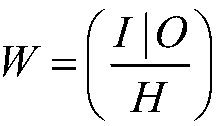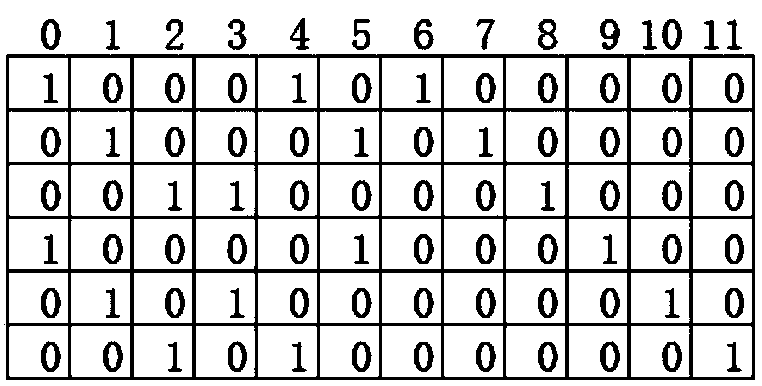Decoding method of erasure codes
An erasure code and decoding technology, which is applied in the field of erasure code decoding, can solve the problems of difficult prediction, low decoding speed, and high algorithm time complexity, and achieve wide application range, speed improvement, and time complexity Reduced effect
- Summary
- Abstract
- Description
- Claims
- Application Information
AI Technical Summary
Problems solved by technology
Method used
Image
Examples
Embodiment 1
[0021] A 2×6 data storage array is known, and each column represents a storage node; the first 3 columns store data elements, and the last 3 columns store check elements, as shown below:
[0022] 0
1
2
6
8
10
3
4
5
7
9
11
[0023] Each check element in the storage array is generated in the following way, where the + sign represents XOR:
[0024]
[0025] Then the parity check matrix H of the codeword can be obtained as follows:
[0026]
[0027] The 0-11 labels on the parity check matrix indicate the elements in the storage array corresponding to this column of the parity check matrix.
[0028] Columns 1 and 2 in the storage array fail after an error occurs, that is, elements 1, 2, 4, and 5 become unknown. That is, in this embodiment, it is known that the check matrix H of an erasure code and the wrong position element are known, the number dNum of data bits in the data storage array is 6, and the specific ste...
Embodiment 2
[0052] Embodiment 2 When there is an error on the check digit
[0053] Still using the storage array structure and check element generation method in Embodiment 1, this time it is assumed that the second and third columns in the storage array fail after an error occurs, that is, data elements 2, 5 and check elements 6, 7 become unknown. The specific steps are as follows:
[0054] S1 is as in Embodiment 1, and is not repeated here:
[0055] matrix
[0056]
[0057]S2. Assign an incremental integer number starting from 0 to each element in the codeword: 0, 1, 2, ...; set the numbered positions of the erroneous elements as errIDs, that is, set 2, 5, 6, 7; Take out an element number from errIDs in order and record it as eID, which is equal to 2, 5, 6, and 7 respectively;
[0058] Implement steps S3 to S5, and repeat until all corresponding numbered eIDs in all errIDs are processed; that is, the same operation is performed for unknown elements 2, 5, 6, and 7, and the follow...
PUM
 Login to View More
Login to View More Abstract
Description
Claims
Application Information
 Login to View More
Login to View More - R&D
- Intellectual Property
- Life Sciences
- Materials
- Tech Scout
- Unparalleled Data Quality
- Higher Quality Content
- 60% Fewer Hallucinations
Browse by: Latest US Patents, China's latest patents, Technical Efficacy Thesaurus, Application Domain, Technology Topic, Popular Technical Reports.
© 2025 PatSnap. All rights reserved.Legal|Privacy policy|Modern Slavery Act Transparency Statement|Sitemap|About US| Contact US: help@patsnap.com



